Vol 5 No. 15 TROPIC LIGHTNING NEWS April 13, 1970
Index
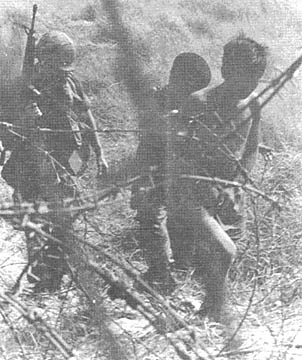 |
AN NVA SAPPER who was involved in an attempt to penetrate the wire of Tay Ninh Base Camp is escorted into the perimeter by an ARVN interpreter who is working with the Regulars of 3rd Battalion, 22nd Infantry. (Photo by SP4 Brian Flaherty) |
Near Angel’s Wing
Hounds Kill 62 in Heavy Contact
By SP4 RICH DOMBROWICKI
FSB BLUE - In one of the largest operations in recent months, three companies
of the 2d Battalion, 27th Infantry Wolfhounds along with other units engaged a
large NVA force northeast of the Angel’s Wing near the Cambodian border.
During two days of heavy fighting 62 enemy were killed. U.S. suffered 11 men
killed. Ten of the wounded had to be evacuated.
Initial contact was established by a small unit of 75th Rangers. Shortly
after insertion at the eastern edge of the Renegade Woods the Rangers received
heavy ground fire from the enemy who were inside well fortified bunkers.
Air strikes, artillery, gunships and ground reinforcements were quickly
called in.
Charlie Company, second Wolfhounds, arrived shortly and established further
enemy contacts. The enemy force was estimated as a battalion and the
Wolfhounds’ Alfa and Bravo companies joined the fight.
The U.S. forces received continuous support from artillery, gunships and air
strikes. Chopper pilots reported spotting as many as 30 enemy bunkers and an
aerial observer reported drawing fire from nine different ground positions.
Fighting continued throughout the day and into the night. Air strikes,
artillery and gunships were used continually and the Wolfhounds managed to
surround the enemy positions.
On the morning of the second day elements of Bravo and Charlie companies, 2d
Battalion (Mech), 22d Infantry joined the fighting along with Delta Troop, 3d
Squadron, 4th Cavalry, a helicopter troop.
Partial searches of the enemy position turned up the enemy bodies. The
Rangers were credited with 12 kills, the Wolfhounds 25, the Cav 5, and the
mechanized companies four. Artillery and the Air Force were credited with
killing eight enemy each.
Southwest of the major contact the Vietnamese 963d Regional Force intercepted
a patrol of NVA wounded heading toward the border. The RFs took 13 prisoners.
Sapper, Rocket Teams Smashed
R.F., First Brigade Repel Tay Ninh Attack
By 1LT ROBERT E. GOLDEN and SP4 BRIAN FLAHERTY
TAY NINH - Hard-core Communists from the North teamed up with local Viet Cong
elements and launched what appeared to be a pre-planned coordinated offensive
against Tay Ninh Base Camp and the surrounding area during the nights of 30-31
March.
Thanks to the keen alertness of 1st Brigade soldiers manning the base camp
bunker line and to numerous Regional Forces companies that were in contact near
the city, the enemy’s efforts failed to achieve any measure of success.
The results of a 40-man NVA element’s attempt to penetrate Tay Ninh Base Camp
ended up with 5 NVA killed in the barbed wire, 2 detainees, plus numerous
weapons and ammunition captured. Seven Americans were wounded during the probe,
but not one of the Communists made it through the wire and the sappers provided
1st Brigade intelligence personnel with valuable information.
While the sappers were quietly inching their way towards the wire, other
enemy elements were busy lobbing mortars, rockets and RPG rounds into base camp
to divert attention from the perimeter. It didn’t work. U.S. forces reacted
with Cobra gunships, Blue Max, artillery, Issue FAC, Nighthawk and a thunderous
volley of organic weapons.
Early morning sweeps by Delta, 3rd Battalion, 22nd Infantry, turned up three
enemy bodies plus the assortment of weapons, which included 3 AK-47s, 80 Chicom
hand grenades, 23 RPG rounds, 2 Bangalore torpedoes, 4 RPG launchers, one Chicom
pistol and one grenade launcher. The other two bodies were picked up by the 4th
Battalion (Mech), 23rd Infantry.
Colonel Paul J. Mueller, Jr., 1st Brigade commander, commended the men on the
bunker line for a job well done. “Everyone did a fine job last night,” the
colonel said, “and it just goes to show that it does pay to be alert on the
bunker line.”
Meanwhile, several companies of the Regional Forces were busy battling
Charlie at several locations south and east of Tay Ninh. Without sustaining a
single loss, the RFs racked up a total of 27 enemy dead from four separate
engagements. Captured equipment included 13 AK-47s, 4 Claymores, 15 Chicom hand
grenades and 2 B-40 launchers.
The Communists’ attempts to overrun U.S. and South Vietnamese bases failed at
every turn. The next night, Tay Ninh Base Camp was again subjected to a rocket
and mortar attack as well as another ground probe. Again, the enemy’s efforts proved futile.
A 1st Brigade intelligence officer said the enemy offensive was part of an
anticipated high point predicted for early April. “This could very well be the
enemy’s last significant effort before the rains come,” he said.
| WATER SAUSAGE - This trooper is not filling his canteen from the stuffings of a sausage, but the Army’s free fall liquid container. The container can be dropped where landing would be impossible for choppers. Helping this Golden Dragon soldier is Cpt. Bennet Jones, Delta Company’s commander. (Photo by SP4 Greg Stanmar) |  |
Page 2 TROPIC LIGHTNING NEWS April 13, 1970
Decorated
| DISTINGUISHED SERVICE CROSS | |
| LTC James E. Coggins, 25th Admin Co | |
|
SILVER STAR |
|
| 1LT Mark W. Davis, Co E, 2d Bn, 27th Inf | 1LT Robert P. Barclay, Co E, 2d Bn, 27th Inf |
|
DISTINGUISHED FLYING CROSS |
|
| LTC George A. Custer, HHC, 2d Bn, 27th Inf MAJ Carmen J. Cavezza, HHC, 3d Bn, 22d Inf CPT Charles R. Otto, HHB, 25th Div Arty CPT Eliseo Pacheco, HHB, 7th Bn, 11th Arty CPT Ronald Sweitzer, HHC, 1st Bn, 5th Inf |
1LT Edward L. Behne, Co A, 25th Avn Bn 1LT Fred M. Perryman, HHB, 25th Div Arty WO1 Howard R. Lusk, HHC, 3d Bde WO1 John M. Lanning Jr., HHB, 25th Div Arty |
| BRONZE STAR FOR HEROISM |
|
|
LTC George A. Custer, HHC, 2d Bn, 27th Inf CPT Ralph G. Laubecher, Co B, 1st Bn, 5th Inf 1LT Wilbur F. Price Jr., Trp B , 3d Sqdn, 4th Cav 1LT Terrence P. Doherty, A Btry, 7th Bn, 11th Fld Arty 1LT Paul K. Altier, HHC, 1st Bde 1LT Albert C. Flagg Jr., Co B, 1st Bn, 5th Inf 2LT Michael C. Sorg, Co C, 3d 22d Inf 2LT Theodore Searcy, Co C, 2d Bn, 14th Inf 2LT Ronald Henderson, Co C, 3d Bn, 22d Inf 2LT John E. Markham, HHC, 2d Bn, 34th Armor SSG Johnnie James, Co B, 1st Bn, 5th Inf SSG Rodney K. Namauu, Co C, 2d Bn, 14th Inf SSG Thomas J. Curren, Co E, 2d Bn, 27th Inf SGT Stephen R. Adams, Co B, 2d Bn, 27th Inf SGT Edward Yapsuga, Co B, 4th Bn, 9th Inf SGT Thomas C. Anderson, Co A, 2d Bn, 34th Armor SGT Dale C. Vick, Co A, 2d Bn, 34th Armor SP5 Robert M. Swadish, Co A, 2d Bn, 34th Armor SP4 Thomas F. Langenburg, HHC, 1st Bde SP4 William L. Abbot, Co D, 2d Bn, 12th Inf SP4 Tommy L. Hutchens, Co C, 2d Bn, 12th Inf SP4 Silvio R. Nicoli, Co C, 2d Bn, 14th Inf SP4 Chatwin Strother, Co C, 3d Bn, 2d Inf SP4 Ray Simpson, Co C, 3d Bn, 22d Inf SP4 Steve B. Todd, Co C, 3d Bn, 22d Inf |
SP4 Neil G. Taylor, Btry B, 2d Bn, 77th Fld Arty SP4 Lawrence R. Campbell, HHC, 1st Bde SP4 Frederick E. Gross, Co E, 2d Bn, 27th Inf SP4 Jerry L. Raymond, Co E, 2d Bn, 27th Inf SP4 Peter J. Schmitt, Co E, 2d Bn, 27th Inf SP4 J. D. Poole, Co B, 4th Bn, 9th Inf SP4 Jan H. Fraze, HHC, 65th Engr Bn SP4 Joseph A. Peveria, Co A, 2d Bn, 34th Armor SP4 Lloyd T. Creeson, Co A, 2d Bn, 34th Armor SP4 Michael E. Kemp Jr., Co A, 2d Bn, 34th Armor SP4 David L. Reel, Co A, 2d Bn, 34th Armor SP4 John S. Richardson, Trp B, 2d Sqdn, 4th Cav SP4 Samuel E. Harrell, Trp B, 3d Sqdn, 4th Cav SP4 Joseph B. Parisi, Trp B, 3d Sqdn, 4th Cav SP4 Dawson Wilkinson, Trp B, 3d Sqdn, 4th Cav PFC Larry D. Werner, Co D, 2d Bn, 12th Inf PFC Arthur Olivas, Co C, 3d Bn, 22d Inf PFC Robert J. Lajiness Jr., Co B, 2d Bn, 27th Inf PFC Ira L. Roork, Co E, 2d Bn, 27th Inf PFC Jimmy L. Lawson, Co B, 4th Bn, 23d Inf PFC Lawrence J. Bielski, Co A, 2d Bn, 34th Armor PFC Donald F. Buffington, Co A, 2d Bn, 34th Armor PFC James G. Beaty, Trp B, 3d Sqdn, 4th Cav PFC Jerome Cherett Jr., Trp B, 3d Sqdn, 4th Cav PV2 Roman A. Gil, Co A, 2d Bn, 34th Armor |
Not Tinker Toys
Faulty Ammo Means Danger
What does one do when he has an explosive which has not detonated properly?
Everyone knows that the explosive should be left alone until someone with
experience in the demolitions field can determine the proper manner in which to
dispose of it.
However, some people who know that they should not attempt to dispose of
explosives refuse to believe what they have been told.
A tank commander, for example, attempted to remove a damaged white
phosphorous grenade from the Sheridan tank’s salvo grenade launcher. Unable to
pry it loose with his hands, he borrowed some tools from another track and
attempted to dislodge the grenade once again. During the second attempt, the
grenade exploded and severely burned the tank commander and three other men in
his platoon.
In another instance, two demolitions team members were attempting to destroy
a Chi Com grenade. They set an initial charge on it but it failed to detonate.
They evacuated the area outside the perimeter. When the demolitions sergeant
returned to the site about ten minutes later with another blasting cap, he found
that a young specialist had run out to dispose of the grenade himself. Although the demolitions men yelled at him to stop, the man
insisted upon throwing the grenade into an old fighting position. The grenade
exploded and the specialist suffered fragmentation wounds to the head, chest,
and right arm.
Remember, explosive charges which have not detonated properly are doubly
dangerous because they are unpredictable. Inexperienced persons should not
apply their curious tinkering to these objects.
Mail No No-No’s
SAIGON - Government Agencies have expressed concern over the many contraband
items entering CONUS in parcels mailed from Vietnam.
Parcels are being carefully examined in U.S. Postal and Customs channels.
Postal clerks are enforcing the provisions that parcel contents and value be
declared and the sender/addressee be properly identified.
In addition persons who attempt to mail narcotic or hallucinogenic substances
violate military, postal and narcotic regulations. Violators are subject to
severe fine or imprisonment.
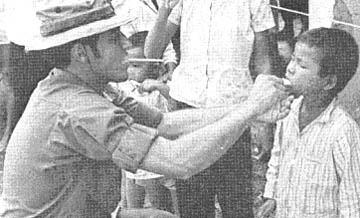 |
UP AND DOWN - Captain David Firestone of Brooklyn, N.Y., a dentist of the 40th Medical Battalion, gives one of the younger villagers of Mui Lon special instructions in the proper care of teeth. (Photo by SP4 Joe Loper) |
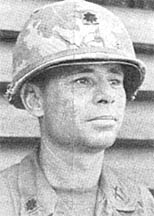 |
Lieutenant Colonel Shepard H. Phillips recently assumed command of the 2d Battalion, 12th Infantry. He was formerly the executive officer of the 1st Brigade, 25th Infantry Division. He replaced Lieutenant Colonel Burton J. Walrath, who now heads the division G-4. |
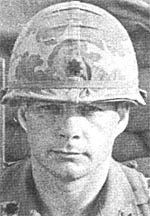 |
Lieutenant Colonel Marvin Rosenstein of Fairfax, Va. assumed command of the 1st Battalion, 27th Infantry. Colonel Rosenstein, who was formerly with the Office of the Deputy Chief of Staff for Military Operations, Department of the Army, replaced Lieutenant Colonel Thomas Whitsel. |
Tropic Lightning Tots
The Commanding General Welcomes
The Following Tropic Lightning Tots
To The 25th Infantry Division – As
Reported By The American Red Cross.
Born To:
| Mar 18 1LT Richard Alivlis, B Co, 2d Bn, 12th Inf, girl Mar 20 SP4 Michael Bone, E Co, 2d Bn, 12th Inf, girl Mar 23 PFC Darrell Hills, B Btry, 1st Bn, 27th Arty, boy Mar 24 SP4 William Wolfe, D Co, 1st Bn, 27th Inf, boy CPT Richard Wagner, Svc Btry, 7 Bn, 9th Arty, girl Mar 26 SP4 Thomas Morrison, B Co, 25th Avn Bn, girl PFC Jerry Besterfeld, 58th APV, girl Mar 27 SP4 Willard Benson, C Co, 125th Sig. Bn, girl PFC Edwin Burr, B Co, 2d Bn, 27th Inf, boy PFC Sam Romo, D Co, 2d Bn, 22d Inf, boy |
Mar 28 SP4 James Stewart, B Co, 25th S&T Bn, girl PFC Alexander Holland, B Btry, 1st Bn, 8th Arty, boy SP4 Jose Rodriguez, Co A, 125th Sig Bn, boy Mar 29 CPL Thomas Minor, B Btiy, 2d Bn, 77th Arty, boy SP4 Stephen Chesebro, B Co, 2d Bn. 27th Inf, boy 1LT Peter Shockley, E Co, 3d Bn, L2d Inf, girl PFC Joseph Gagne, C Co, 3d Bn, 22d Inf, boy Mar 30 SP4 Ganest Liimatainen, B Co, 25th S&T Bn, boy SP4 Lester James, B Co, 4th Bn, 23d Inf, girl Apr 1 1LT Eric Schmidt, C Co, 3d Bn, 22d Inf, boy |
The TROPIC LIGHTNING NEWS is an authorized publication of the 25th Infantry Division. It is published weekly for all division units in the Republic of Vietnam by the Information Office, 25th Infantry Division, APO San Francisco 96225. Army News Features, Army Photo Features, Armed Forces Press Service and Armed Forces News Bureau material are used. Views and opinions expressed are not necessarily those of the Department of the Army. Printed in Tokyo, Japan, by Pacific Stars and Stripes.
MG Edward Bautz, Jr . . . . . . Commanding General
1LT John Caspari . . . . . . . . . Officer-in-Charge
SSG Stephen F. Veroczi . . . . NCOIC
SP4 Charles C. Self . . . . . . . . Editor
SP4 Gary D. Sciortino . . . . . Assistant Editor
BATTALION CORRESPONDENTS
| SP4 Dennis Bries SGT Bill Obelholzer SP4 Jim Williams SGT Wally Baker SP4 Greg Stanmar SP4 Phil Jackson SP4 Jeff Hinman SP4 Doug Sainsbury SP4 Ken Barron SP4 Greg Duncan SP4 Brad Yaeger SP4 Frank Rezzonico SP4 Dan Neff |
2/22 4/23 2/12 2/34 2/14 2/27 2/12 2/77 1/8 2/27 1/27 1/27 7/11 |
SP4 Henry Zukowski SP4 Joe O'Rourke PFC Ray Byrne SGT William E. Zarrett SP4 Robert Caplan SP4 Brian Flaherty SP4 Rich Fitzpatrick PFC Rob Lato SP4 Ken Johnson SP4 Frank Salerno SP4 Lawrence Merritt SP4 William McGown |
2/22 3/4 2/14 4/9 4/23 3/22 1/5 2/27 2/34 2/22 4/9 DivArty |
Page 3 TROPIC LIGHTNING NEWS April 13, 1970
He’s Everywhere, He’s Everywhere
Chaplains’Aim: Make Everyday Sunday in the Field
By PFC RICHARD CONNELL
BEARCAT - Sunday is normally the day for worship services back in the World,
but here in Vietnam so are Monday, Tuesday, Wednesday and the rest of the days
of the week.
“Sunday is not that important as a day of worship because we can’t get to
everyone on that day,” said Major Arthur Solem of Superior, Wisconsin in
explaining his job and that of the rest of the Chaplains of the 2nd Brigade.
The goal of the four Chaplains (three Protestant and one Roman Catholic) is
to give each man in the Fire Brigade the opportunity to attend religious
services at least once a week. This is a big goal and it means that one of the
Chaplains, and often more, is in the field daily.
“The field is really the best place for services,” said Solem. “Out there we
get the best attendance and the men really listen to what we have to say.”
But reaching the men in the field is often difficult. Many of the Fire
Brigade’s Battalions work in small units, some in only platoons. This means the Chaplains must not
only be messengers of God’s word, but also Pathfinders as well.
“If we don’t catch the men while on operation, we try to get to the whole
Battalion when it’s being re-supplied,” explained Solem.
The Chaplains also like to spend a day on operation with a full company.
“I think the men like to see you out there with them,” said Captain Philip
Blake of San Jose, California, the Brigade’s Roman Catholic Chaplain.
“Throughout the day the men will come up to you and ask questions or just talk.”
Blake is probably the busiest of the busy Chaplains as he is the only Roman
Catholic Chaplain and must try to reach all of the Roman Catholic personnel in
the Brigade each week.
“In the first three weeks here in Bearcat base camp, I spent about twenty
hours in the air trying to get to everyone,” said Blake.
Probably the best way to understand the effectiveness of a Fire Brigade
Chaplain is to spend a day in the field with him. As the Chaplain arrives at
the camp site heads turn and smiles light up. There are greetings, handshakes
and, of course, the important question, “Will there be services today,
Chaplain?”
| LET US PRAY - Robert Miller, a Protestant chaplain for the second brigade, leads the men of Bravo Company, 1st Battalion, 27th Infantry, in prayer during services near Fire Support Base Colorado. Chaplain Miller is from Baltimore. (Photo by PFC Rick Connell) |
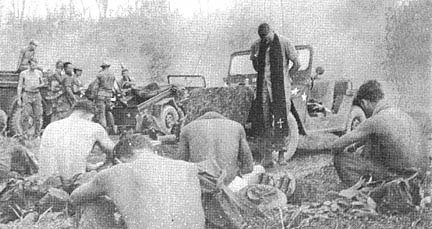 |
Triple Deuce on Right Tracks Thanks to Skills of Mechanics
By PFC FRANK H. SALERNO
CU CHI - The mechanics of Bravo Company 2nd Battalion (Mech), 22nd Infantry
use a lot of patience and plenty of skill to repair and rebuild armored
personnel (APC) carriers everyday.
“Lately our biggest problem is overheating of engines due to radiator leaks,”
said Specialist Glenn Goff, of Parkersburg, W. Va. “Other jobs include
replacing worn out engines, shock absorbers, generators, wheel seals and
bearings. I take pride in my job because I know my unit depends on the APC’s.”
The mechanics can take out a worn engine and replace it usually within 45
minutes to an hour.
“After you finish one job, there’s always another waiting,” said Sergeant
Thomas Dudek, a mechanic, from Chicopee, Mass.
“The hours and terrain here are demanding,” Dudek continued. “This is why
many problems persist. Taking this into consideration the carriers perform
well,” he added.
At the end of a day the mechanics fill out their log books. Each track has a
record of what has been done to it, how many parts have been replaced, and the
mileage.
A mechanic is assigned to each platoon in the company and at the end of each
day, he checks with the drivers of the carriers. The driver checks the oils and
water, and cleans out the air filter. The mechanic makes minor or major repairs
if necessary.
“Our mission is to be with our carriers 24 hours a day, whether they’re at a
fire support base or in the field on a night laager of recon,” said motor pool
Staff Sergeant Gar Brandon of Taullohoma, Tenn., a former carrier mechanic
instructor, at Fort Knox, Ky.
“Each man spends 8 to 12 hours a day maintaining our tracks,” he said. “I’ve
got the best mechanics I’ve ever had in the past six years. Some of them I
taught myself at Fort Knox. It’s really great to work with them because they
cooperate so well.”
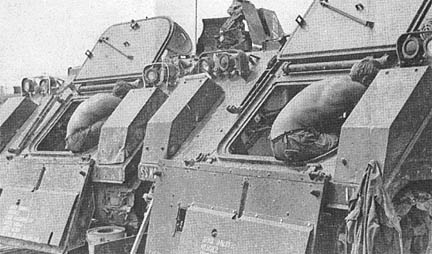 |
| DIGGING IN - Mechanics of Bravo Company, 2d Battalion, 22d Infantry, work in the engine compartments of two armored personnel carriers making necessary adjustments and repairs. (Photo by SP4 Henry Zukowski) |
Evening Air Reconnaissance Stops Enemy Near Cu Chi Wire
By SP4 JOE O’ROURKE
CU CHI - A light scout team from Delta Troop, 3d Squadron, 4th Cavalry, was
working a routine last light mission around the perimeter.
Suddenly, Warrant Officer Gary F. Center, Bountiful, Utah, the light
observation helicopter pilot, spotted the group of enemy only a few hundred
meters from the base camp perimeter. He swung his aircraft around in a tight,
rapid turn and headed directly for the group.
The aircraft was met with a hail of automatic weapons fire. Center gave the
order to open fire as soon as he was in position to avoid firing into the base
camp. The enemy group scattered leaving pots of rice, still cooking, and
supplies lying haphazardly in the area. As they fled they continued to engage
the helicopter with small arms fire.
Machinegun fire from the helicopter killed three of the enemy and wounded a
fourth as they ran for cover in nearby tunnels. Center called on the Cobra team
to fire a rocket barrage into the tunnels. Then he landed his ship and his crew
gathered the equipment abandoned by the enemy.
The captured equipment included two pistols, one rifle, four pounds of rice,
clothing, medical supplies and assorted other supplies.
Triple Deuce Company Has Picnic with Charlie
By SP4 HENRY ZUKOWSKI JR.
CU CHI - Don’t prepare a home cooked meal and expect Triple Deuce to stay
away.
During recent search operations conducted by Bravo Company, 2nd Battalion (Mech),
22nd Infantry, three miles north of Cu Chi, a large enemy feeding station was
found.
The NVA were just about to enjoy their noon chow when the Triple Deuce
unexpectedly dropped in.
“The ovens were still hot and the fish was still frying in the pans,” said
Specialist Four Daniel Jacobs of Niles, Mich.
Although most of the enemy managed to clear out in time, the Triple Deuce did
give one a fatal attack of “indigestion.”
The total find was one VC killed, 500 lbs. of rice, four ChiCom stoves,
canteen cups, a dozen mackerel and tuna cans, fresh fish, squash, peppers, and
cooking spices, pots and pans, cups, eating utensils, and five water jugs.
Elsewhere in the area the men found 200 AK rounds, one AK-50 rifle, one RPG
launcher, six RPG rounds, two entrenching tools, one 40 lb. Chi-Com shape
charge, one Chi-Com binoculars, five NVA uniforms, and numerous medical
supplies. Twenty fighting positions, 12 bunkers, and numerous tunnel complexes
were destroyed.
“The operation was a noteworthy achievement because we were so close to
friendly forces that air strikes could not be used. Therefore, the Triple Deuce
had to go in alone and flush the enemy out,” said Specialist Four John Roberts
of Turkey Creek, La., a rifleman.
Lightning Benny Selling Trinkets
TAY NINH - Tropic Lightning Association souvenir items are now available
through a traveling salesman, Spec 4 Herbert Herrman, who prefers to be known as
Tropic Lightning Benny. Benny swept the Tay Ninh Base Camp in the beginning of
April and will cover the entire AO within the next months.
Benny was last seen in this area selling subscriptions to the Division
Yearbook. Souvenir items to be sold within the next few months include letter
openers, wallets and drinking mugs.
Page 4-5 TROPIC LIGHTNING NEWS April 13, 1970
Knights are Bold
Crusaders Means ‘A Lot of Help in a Hurry’
|
||||
 |
||||
| ARVNS get ready to hop aboard for airlift to a new ground operation area. | ||||
|
| Story and Photos by SGT Danley E. Delaney |
TAY NINH - Black Barons, Red Ryder, White Maggots, Lancelot, and Ye Holy
Land. Something out of medieval England?
Ringing of the round table and knights of old, these titles are appropriate
for the flying Crusaders, men of the 187th Assault Helicopter Company, commanded
by Major John R. Gantt, Kingsport, Tenn.
The Crusaders were activated September 1, 1966 at Fort Bragg, North Carolina,
and came to Vietnam in March, 1967 as the “Blackhawks”. They began combat air
assault operations April 1, 1967. In March, 1968, the Blackhawks changed their
name to Crusaders. The name goes with what the crest of the unit symbolizes:
strength and honor, courage, valor, and a moral obligation to fight for the
freedom of men.
From the company’s base, “Ye Holy Land” at Tay Ninh, pilots and crewmen
maneuver their helicopters in airmobile operations throughout the fighting area
of the 25th Infantry Division, providing ground commanders with close air fire
support, air mobility of troops, supplies and equipment.
Crusader pilots fly missions for several different units during a day’s
flying time which lasts eight hours or more, picking up troops at pickup zones
and setting them down in landing zones.
Communications between the ground, gunships, the eagle flight (a group of
lift ships), ground units being picked up, and artillery observers is a constant
requirement for precision in flying an aerial formation of eight aircraft or
more. Frequencies (freqs) are changed often, to keep troop movements as secure
as possible.
When the last round of artillery hits an LZ being prepped (prepared for
landing) the first ship in the flight sails down to drop off a load of troops,
while the other ships in the flight land close behind. As soon as the troops
are off, the aircraft lifts away from the ground and from the LZ to pick up the
rest of the ground unit and bring them in.
Cobra gunships from the 187th (the Rat Pack) are a hard hitting air strike
force, part of the Crusader’s support team. Armed with rockets, mini-guns and
the rapid-fire 40MM grenade launcher, Ratpack Cobras circle the LZ’s and pick-up
zones (PZ’s) to keep the enemy down while troops load on or off the eagle
flights.
Ground commanders also use Snakes (as the Cobras are called) as instant
artillery when they get in a tight spot. The Ratpack pilot lines up his sights
on the enemy position and lets his rockets go; then mini-guns; then 40MM grenade
launchers - 300-a-minute and Charlie knows he has been shot at.
For every operation there is a Command and Control ship, called C&C or Circle
and Circle. The C & C ship carries the ground commander, usually a battalion
commander. From his air mobile vantage point the battalion commander can direct
the maneuvering of his companies over a large area of ground.
Maintenance on helicopters is a job every Crusader takes seriously. When an
engine fails on a ship in the air there is no shoulder of the road, there is no
place to pull over and park. When a Huey hits the ground and its JP-4 fuel
burns, the magnesium of its skin burns white hot at hundreds of degrees until it
is only a twisted black skeleton.
Aircraft crewmen, pilots and co-pilots, working with the ground mechanics, do
an extensive pre-flight check of their aircraft every day before they fly.
Crusaders work to support the troopers on the ground. They can bring in a
lot of help in a hurry.
 |
| CRUSADERS - Warriors of Charlie Company, 2d Battalion, 12th Infantry, rise to greet their transportation back to Fire Support Base Kien after a long day in the field. |
Page 6 TROPIC LIGHTNING NEWS April 13, 1970
Hello Mom, Over
Mobile Radio Helps Outposts
By PFC RICK CONNELL
BEARCAT - G.I.s in the Fire Brigade who have something to say are saying it
and saying it to people who will listen, thanks to the Military Affiliate Radio
System (MARS). The MARS Station at the 2nd Brigade’s basecamp in Bearcat is the
only one of its kind in the 25th Infantry Division because it is mobile.
According to Sergeant James Hahne of Virginia, Minnesota, the NCO in charge,
the response to the MARS station in Bearcat has been very good.
“We’re handling about 15 to 20 calls a day,” he said. “I especially like to
see the men from the field use the station whenever they get into Bearcat.”
The MARS station, located in the Fire Brigade’s Headquarter’s Company area,
is open from 0700 until 1200 hours for stateside calls.
Each call, limited to three minutes, is handled much like a collect call back
in the World. The MARS station contacts a United States military installation
in the States which makes the final connection via the public telephone system.
The cost of the call depends on the distance of the military installation
from the home of the person being called. Hahne added that the connection
usually takes anywhere from five minutes to an hour to complete.
“Our connections have been very good lately,” Hahne said, “but it all depends
on seasonal and atmospheric conditions.”
The major difference between a MARS call and a regular phone call is that the
MARS call is a one-way system. This means that only one person on the line can
talk at a time. Therefore at the end of each response the caller must say
“Over” to let the operator know when to turn on the other party’s transmitter.
However, Hahne says that there is usually no trouble with this procedure
because both the caller and the person being called are briefed before the final
connection is made.
Hahne noted that most problems with the MARS system are caused by the person
making the call.
“In the excitement of talking to someone back in the World, a lot of guys
forget what they want to say,” he said. “I try to encourage people to think
about what they want to say before they call, even to take a few notes. Three
minutes isn’t a very long time when you’re talking to someone back in the
World.”
| HOME IS A MARS call away for Second Brigade troopers who use a mobile unit set up recently. First Lieutenant Jim Burke, Brockton, Mass., weapons platoon leader for Alfa Company, 1st Battalion, 27th Infantry, called his wife to make plans for an R&R in Hawaii. (Photo by SGT Ray Pompilio) |
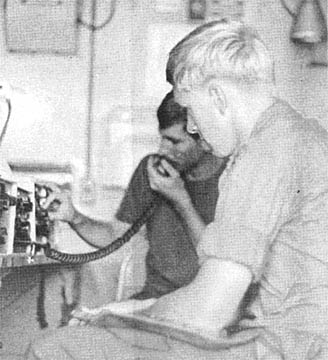 |
| Ilikai East by Night WED-Floor Show THU-Jam Session FRI-Cookout SAT-Films and Popcorn SUN-Cash Bingo MON-April Birthday Party TUE-Badminton All events begin at 2000 hours. |
Arty Recon Sergeant Decorated for Heroism
By SP4 WILLIAM L. MCGOWN
CU CHI - An artillery reconnaissance sergeant was awarded four valor medals
including a silver star and a purple heart recently in a ceremony at
headquarters, 3d Battalion, 13th Artillery.
The Silver Star was presented to Sergeant Steven F. Leapley of Troy, Ohio,
for his actions February 1 while he was attached to Bravo Troop, 3d Squadron,
4th Cavalry.
During a night reconnaissance his unit was ambushed by a large enemy force.
“At 7:30 we were inserted within 200 meters of our ambush site,” Leapley
said. “We stayed in a hold position until darkness and prepared to move out.”
“One of our men thought he saw movement in the bushes which encircled our
front,” Leapley said. “A sergeant checked it out and said he could find nothing
but thought there were some people there.”
At that moment the enemy element opened fire on the patrol killing one man
and wounding several more.
“A grenade landed beside me and the platoon leader,” Leapley said. “The
lieutenant threw himself on the grenade saving the majority of the men.”
Leapley was wounded by the explosion but took over the platoon. He dragged
the dead and wounded about 40 meters into a bomb crater as the rest of the men
returned enemy fire.
“We set up in the crater, made radio contact with our command and asked for
support,” Leapley said. “We continued to lay down fields of fire and began
treating the wounded.”
Air support arrived about ten minutes later and the seriously wounded men
were evacuated. Leapley and his men searched the area before heading back to
Fire Support Base Wood III.
Other medals presented to Leapley were two Bronze Stars for valor and an Army
Commendation Medal for valor.
Ask Sgt. Certain
DEAR SGT. CERTAIN: I’m a Vietnam veteran and I’m doing research for a college
term paper on “Rare Quadrupeds Indigenous to Tay Ninh Province.” Do you have
any information that may help me in my research’?
ORNITHOLOGIST
DEAR ORNERY: It just happens that last week a platoon from the 4th Battalion,
9th Infantry Manchus came upon something that has been hailed as “The greatest
discovery since Piltdown Man” by zoologists and anthropologists throughout
Asia. It is the Southeast Asian Thumping Lynx. It was only the second sighting
of the beast since 1896 when Sir Orville Nefter, a famed British ornithologist,
spotted the lynx while walking through the jungle. Nefter was attacked by the
beast and was badly thumped about the head and shoulders but managed to describe
the animal to his rescuers. I quote from his book “Stranded in the Jungle.”
“It was about three feet long and thirty inches tall - similar to the common
lynx of North America and Asia. But, unlike any other known member of the
Felidae (Cat) Family, the thumping lynx has no teeth. He is a gummer. Also,
the tail of the thumping lynx is about four feet long and has a hard knot about
five inches in diameter at the end. This serves as the animal’s chief defense
mechanism as well as giving the lynx its name. It is believed by most experts
that the Thumping Lynx ‘Thumps’ its victims to death before gumming them.”
Photos taken by the Manchus are currently being studied by the National
Geographic Society in New York.
Page 7 TROPIC LIGHTNING NEWS April 13, 1970
 |
| THE MEDICS’ TRACK sets behind the third platoon as the Tomahawks prepare to dismount for their mission at the base of Nui Ba Den. |
Tomahawks Besiege Mountain, VC
NUI BA DEN - The legendary Black Virgin Mountain in Tay Ninh Province has
been an enemy stronghold for many years.
It is honeycombed with caves which make ideal bunkers for the estimated enemy
battalion within. These caves provide protection against the continuous
shelling and bombing by artillery and airstrikes. The mountain houses the enemy
communications network and is their assembly and reassembly point.
Although the mass of granite appears io be impenetrable, the Tomahawks of the
4th Bn. (Mech) 23rd Inf. have effectively lessened the enemy’s approaches and
departures from the mountain. With the Tomahawks constantly screening around
the base of the mountain with their armored personnel carriers, supplies are
difficult to get in and men are difficult to get out.
The Tomahawks also send out night ambushes from FSB Buell and ambush patrols
are sent out from their night laager sites.
Sergeant Mike Keyster of Peoria, Ill., a squad leader for Alfa Co., said, “I
believe if we’re going to catch them unaware, the secret is being at the right
place at the right time.”
So the mighty mountain still stands, but the constant harassment by the
Tomahawks has made life uneasier and much more precarious for the enemy soldier
holed up within.
|
Story, Photos By SGT Bill Oberholzer |
| CALLING IN - Sergeant John Mohlar (far background) of Canonsburg, Pa., a reconnaissance NCO, prepares to call in artillery as the Tomahawks take some incoming rounds from the mountain. He and his radio-telephone operator, Specialist Four Ross Ciccarello (foreground) of Tampa, Fla. are attached to the Tomahawks’ Charlie Company as Forward Observers. |
 |
 |
HANGING THEM IN - Private First Class Larry Creech of Middletown, Ohio “hangs” an 81mm mortar round as Specialist Four James McGee of Austin, Minn. prepares himself for the blast. The Tomahawk mortarmen were prepping an area on Nui Ba Den from their night defensive position. |
| STEPPING SOFTLY - The headquarters element of Charlie Company, 4th Battalion (Mech), 23rd Infantry moves cautiously through an open area during a sweep at the base of the Black Virgin Mountain. |
 |
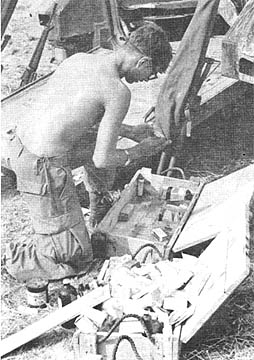 |
TIME OUT - ”Doc” Martin (Specialist Four Keith Martin of Elmira, Wyo.), a medic for the Tomahawks Charlie Company, straightens out his medical supplies after a hectic day at the base of the mountain. |
Page 8 TROPIC LIGHTNING NEWS April 13, 1970
Tomahawks Shine
CG Presents Silver Stars to 13 Nui Ba Den Fighters
By SGT BILL OBERHOLZER
FSB BUELL - Thirteen men from the 4th Battalion (Mech.), 23rd Infantry, were
awarded the Silver Star Medal for Heroism recently by Major General Harris W.
Hollis, former 25th Division commander. The medals were awarded for three days
of fighting near Nui Ba Den.
Six of the awards were made at Fire Support Base Buell, home of Alfa Company
Tomahawks. Presented with Silver Stars for Alfa Company were Captain M.V.
Crocetti, Alfa’s commander, Private First Class Phil Gay of Lancaster, S.C., a
track commander, Specialist 4 John Williams of Timbo, Ark., a medic, Sergeant
James Anibas of Eau Claire, Wis., the mortars forward observer, and First
Lieutenant Reginald Smith of Sharon Hill, Pa., the 1st Platoon leader.
Immediately following the ceremony at Buell, General Hollis flew to Charlie
Company’s night defensive perimeter at the base of Nui Ba Den for another awards
presentation.
The seven men of Charlie Company who received the Silver Stars were Captain
Terry O’Hara of Mayfield Village, Ohio, Charlie Company commander, Specialist 4
Keith Martin of Elmira, Wyo., a medic, Specialist 4 Charles Morgan of Lebanon
Jct., Ky., an APC driver, Sergeant Gary Berg of Litchfield, Minn., a squad
leader, Specialist 4 Jose Morales of Reedly, Calif., a rifleman, Specialist 4
James Holt of Landover, Md., a medic, and Staff Sergeant Kim Fisher of Salt Lake
City, Utah, a platoon sergeant.
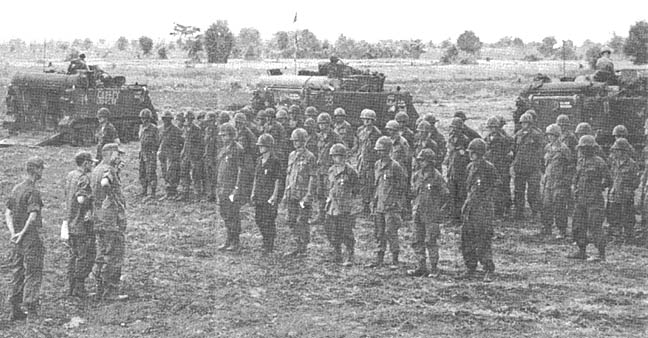 |
| IMPACT AWARDS - Seven of the thirteen 4th Battalion (Mech), 23d Infantry Tomahawks decorated for valor stand in formation at a night defensive position. Silver Stars were presented to the men by former division commander Harris W. Hollis after they distinguished themselves during fighting on Nui Ba Den. (Photo by SP4 Robert C. Caplan) |
Laterite Stompers Making Grade
Road Leaves Ox Carts in the Dust
By SP4 ALTON TUCKER
TRANG BANG - It was hot and humid with temperatures in the high nineties.
Men were perspiring profusely as they worked. Dust was about six inches thick
and made billowing clouds as the dump trucks and the grader thundered by. This
was the scene south of Trang Bang where recent upgrade work is being done by
First Platoon of Bravo Company, 65th Engineers.
The upgrade work is being done on “No Name Road” and involves bringing in
fill from a nearby load site, mixing the laterite with lime, spreading the soil
and leveling the road. The main problem which has confronted Bravo’s “Laterite
Stompers” has been the settling of the soil, resulting in more time being spent
regrading.
The project, led by 1LT Marvin Beck of Richmond, Virginia, and SSG Stanley
Tomasky of Long Island, N.Y., is a part of an effort to upgrade all secondary
roads in the Division AO and with the prospect of having to regrade some areas,
the men of Bravo Company may be enduring heat and dust longer than expected.
No Name Road, alias route 700 and previously used only by ox-carts and
smaller vehicles, is a 4 klick stretch of road which links QL1 and TL7A south of
Trang Bang. Once upgrade work has been completed No Name Road will be capable
of handling normal highway traffic, except during the rainy season.
| NO NAME ROAD - A road formerly open only to ox carts was carved out of the dust south of Trang Bang by Bravo Company, 65th Engineers. The road can now handle normal highway traffic during dry weather. (Photo by PFC Patrick Demerse) |  |
Artillery Strikes Back
Wizardry Spotting Charlie’s Hardspots
By SP4 DAN NEFF
DAU TIENG - One of the most frustrating tactics used by the enemy is the
long-range mortar or rocket attack. The enemy mortarmen usually strike quickly
and without warning. While the allies try to figure out where the rounds are
coming from, Charlie is running for safety.
Locating a mortar position in the middle of the night may sound like an
impossible task. But, with the electronic wizardry of a Counter-Mortar Radar
Unit and a little luck, it can be done.
The radar transmitter sends out beams that shows an angle which indicates the
path of the round. A computer uses this information to determine the origin of
the round. The process locates the mortar tube in a matter of seconds.
The 25th Division’s CounterMortar Radar installation here is operated by
personnel from the 1st Battalion, 8th Artillery, who work closely with the 7th
Battalion, 11th Artillery’s Fire Direction Center to coordinate artillery fire
on radar sightings.
The radar beams show up on the scope as horizontal lines. When the radar
detects a projectile, the operator marks where it crossed the lines with a
grease pencil. Then he adjusts hairlines onto the marks and the computer
calculates the position of the mortar tube.
The radar equipment is also used to register artillery. This is a process
similar to zeroing an M-16. The artillery fires a round at a certain point, and
the radar calculates coordinates of where the round landed. If there is any
discrepancy, the artillery makes an adjustment until they are firing right on
target.
Kit Carson in the Hole
A Triple Deuce Trump
By SP4 HENRY ZUKOWSKI
CU CHI - Kit Carson was a legendary frontier scout whose adventures were
characterized by feats of valor and extreme heroism. For the men of Bravo
Company, 2nd Battalion (Mech), 22nd Infantry, their Kit Carson Scout is a
Vietnamese copy of that original American Hero.
During recent search operations by the Triple Deuce company a large bunker
complex was being destroyed.
The second platoon Kit Carson Scout, Nguyen Van Sinh, came upon a
suspicious-looking tunnel. The scout motioned for his team members to stay
back.
“I looked in the hole and saw a leg quickly disappear,” said Sinh. “I tried
to talk the VC into giving up but it was no use.”
Sinh, with a flashlight and a .45 caliber pistol, slowly started down the
long and deep tunnel. Soon he came face to face with the VC. Just then his .45
jammed and he retreated hastily.
Sinh, undaunted, and with working .45 in hand, plunged back into the
darkness. Minutes passed as Sinh’s comrades waited. Suddenly they heard
several muffled blasts of small arms fire, followed by dead silence. Finally
after some anxious moments, Sinh greeted his friends with a grin.
Sinh had accomplished his task and had killed his foe. Also captured was one
loaded AK-50 rifle, one RPG launcher, four RPG rounds, one 40 lb. shape charge,
ten mackeral cans, 30 lbs. of rice, one entrenching tool, a large bag of fresh
fish, and two NVA uniforms.
His valorous actions did not go unnoticed. Sinh was awarded the Army
Commendation medal for valor, something Kit Carson would have been honored to
receive.
Thanks to:
Karl Karlgaard, 2nd Bn., 27th Inf., and a Tropic Lightning News correspondent,
for sharing this issue,
Kirk Ramsey, 2nd Bn., 14th Inf. for creating this page.
This page last modified 02-24-2005
©2005 25th Infantry Division Association. All rights reserved.